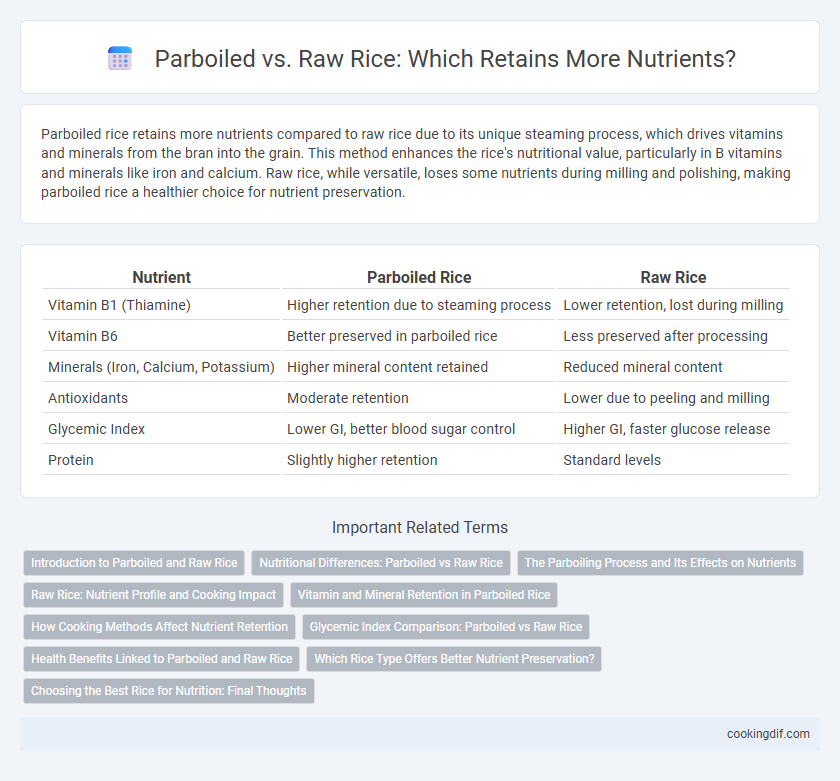Parboiled rice retains more nutrients compared to raw rice due to its unique steaming process, which drives vitamins and minerals from the bran into the grain. This method enhances the rice's nutritional value, particularly in B vitamins and minerals like iron and calcium. Raw rice, while versatile, loses some nutrients during milling and polishing, making parboiled rice a healthier choice for nutrient preservation.
Table of Comparison
| Nutrient | Parboiled Rice | Raw Rice |
|---|---|---|
| Vitamin B1 (Thiamine) | Higher retention due to steaming process | Lower retention, lost during milling |
| Vitamin B6 | Better preserved in parboiled rice | Less preserved after processing |
| Minerals (Iron, Calcium, Potassium) | Higher mineral content retained | Reduced mineral content |
| Antioxidants | Moderate retention | Lower due to peeling and milling |
| Glycemic Index | Lower GI, better blood sugar control | Higher GI, faster glucose release |
| Protein | Slightly higher retention | Standard levels |
Introduction to Parboiled and Raw Rice
Parboiled rice, also known as converted rice, undergoes a steam treatment before milling, which enhances nutrient retention, especially thiamine and other B vitamins, compared to raw rice. Raw rice, or white rice, is milled without pre-treatment, resulting in a loss of some water-soluble vitamins during processing. The parboiling process improves the rice's nutritional profile and increases its shelf life while maintaining a firmer texture after cooking.
Nutritional Differences: Parboiled vs Raw Rice
Parboiled rice retains higher levels of vitamins and minerals, such as thiamine and iron, compared to raw rice due to the steaming process that drives nutrients from the bran into the grain. Raw rice loses more nutrients during milling because the outer layers containing essential nutrients are removed without prior treatment. The glycemic index of parboiled rice is lower than that of raw rice, making it a nutritionally superior option for sustained energy and better blood sugar management.
The Parboiling Process and Its Effects on Nutrients
The parboiling process involves soaking, steaming, and drying rice before milling, which drives water-soluble nutrients like thiamine and niacin from the bran into the grain's endosperm, enhancing nutrient retention compared to raw rice. This technique preserves higher levels of vitamins and minerals, including iron and calcium, by reducing nutrient loss during milling. Consequently, parboiled rice offers improved nutritional value, particularly in maintaining B vitamins and essential minerals, making it a healthier choice over raw rice.
Raw Rice: Nutrient Profile and Cooking Impact
Raw rice retains higher levels of vitamins such as thiamine, niacin, and riboflavin compared to parboiled rice due to minimal processing that preserves the bran and germ. Cooking raw rice typically results in some nutrient loss, particularly water-soluble vitamins, but steaming or using minimal water can help retain more nutrients. Its nutrient profile includes essential minerals like magnesium, phosphorus, and manganese, which contribute significantly to dietary needs when cooked properly.
Vitamin and Mineral Retention in Parboiled Rice
Parboiled rice undergoes a steaming process that drives vitamins and minerals from the bran into the grain, significantly boosting nutrient retention compared to raw rice. This method preserves higher levels of B vitamins such as thiamine, niacin, and folate, along with essential minerals like iron and calcium. As a result, parboiled rice offers enhanced nutritional benefits, making it a healthier option in terms of vitamin and mineral content.
How Cooking Methods Affect Nutrient Retention
Parboiled rice undergoes soaking, steaming, and drying before milling, which drives nutrients like thiamine and iron from the husk into the grain, resulting in higher nutrient retention compared to raw rice. Cooking methods such as boiling or steaming parboiled rice preserve these nutrients better than frying or excessive water loss, which can deplete vitamins and minerals in raw rice. Studies show that parboiled rice retains up to 80% of its original thiamine content after cooking, while raw rice can lose more than 40%, highlighting the impact of both processing and cooking on nutrient preservation.
Glycemic Index Comparison: Parboiled vs Raw Rice
Parboiled rice has a lower glycemic index (GI) compared to raw white rice, making it a better option for blood sugar control. The parboiling process drives nutrients from the bran into the grain, which not only enhances nutrient retention but also slows carbohydrate digestion. Consequently, parboiled rice leads to a steadier blood sugar response, beneficial for individuals managing diabetes or seeking sustained energy release.
Health Benefits Linked to Parboiled and Raw Rice
Parboiled rice retains more vitamins and minerals compared to raw rice due to its steaming process, which drives nutrients from the bran into the grain. This increased retention offers health benefits such as improved energy metabolism and better blood sugar control, making it a favorable choice for diabetic individuals. In contrast, raw rice contains fewer nutrients but has a lower glycemic index, which can aid in weight management and digestive health.
Which Rice Type Offers Better Nutrient Preservation?
Parboiled rice retains more nutrients compared to raw rice due to its steam treatment process, which drives vitamins and minerals from the bran into the grain, enhancing its nutritional profile. This method preserves higher levels of thiamine, iron, and calcium, making parboiled rice a better choice for nutrient preservation. Raw rice, while less processed, tends to lose essential nutrients during milling and polishing, resulting in lower overall nutrient retention.
Choosing the Best Rice for Nutrition: Final Thoughts
Parboiled rice retains higher levels of vitamins and minerals compared to raw rice due to the soaking and steaming process that drives nutrients from the bran into the grain. Nutrient retention in parboiled rice includes significant amounts of thiamine, niacin, and magnesium, making it a superior choice for balanced nutrition. Raw rice often loses more nutrients during milling, resulting in lower overall vitamin and mineral content than parboiled varieties.
Parboiled vs Raw rice for nutrient retention Infographic

 cookingdif.com
cookingdif.com